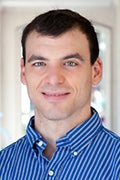
In the 1950s and 60s, Charles Atlas and Jack LaLanne were household names. They represented the ideals of fitness to millions and increased awareness of the benefits of a healthy diet and vigorous exercise. There is another name, not as well known, but arguably as influential: Debbie Drake.
Ben Pollack, a graduate student in the Department of Kinesiology and Health Education, recently wrote a paper on Drake and has received the Best Paper Award from the North American Society for Sport History (NASSH).
The paper, ‘Hot’ Body for a ‘Cool’ Medium: Debbie Drake, TV and the Beginning of the Late Twentieth Century Women’s Fitness Movement, examines Drake’s career—from small-town Texas girl to the host of The Debbie Drake Show, a nationally syndicated televised exercise program.
Drake was one of LaLanne’s most prominent marketplace competitors in the early 1960s. Like LaLanne, she’d abandoned poor habits in favor of a strict diet and exercise routine. She made her television debut in 1961 after working for American Health Studios, an early health club chain, in Dallas in the 1950s.
“Drake’s success was a product of desirable aesthetics, powerful marketing based on sex appeal, and the historic moment in which her show aired. Her vision of fitness had little grounding in scientific or medical research. The diets and exercises she prescribed were likely ineffective or even unhealthy,” Pollack says.
Drake hosted her show wearing not much more than a tight leotard at a time when most Americans weren’t used to such public displays. The costume caught on as women and men were attracted to Drake’s aesthetic.
Associating aesthetics and sexuality with fitness, though, indirectly encouraged women to diet and exercise not for the sake of health, but to resemble Drake’s narrowly defined beauty ideal. Today, some women struggle to attain that ideal because fit bodies in the media are usually surgically or digitally enhanced.
“Understanding how Debbie Drake rose to—and fell from—fame in the 1960s sheds light on modern problems like female participation in school physical education programs, changing generational attitudes toward exercise, and the future of the fitness industry in the digital age,” Pollack says.
Unrealistic aspirational figures like modern fitness models contribute to the tendency of some women to underestimate their abilities and, in some cases, avoid exercise altogether.
Pollack’s current research is focused on the history of physical culture in the twentieth century, and more specifically on how many entrepreneurial ventures have exacerbated problematic trends in the modern fitness industry.
“Many of these men and women resorted to arguably insidious marketing tactics to build their successful businesses,” Pollack says. “Those strategies have contributed to issues like inequality in participation and attitudes toward physical fitness and education across genders; the deceptive advertising that pushes untrue information about training methods, nutritional supplements, and even aesthetic surgeries; and the unrealistic portrayal of ideal or healthy bodies.”
Pollack’s graduate dissertation, tentatively titled, Becoming Jack LaLanne: Beginning the American Fitness Television Industry, 1914-1963, examines the early life of Jack LaLanne, when the fitness mogul transitioned from an inactive lifestyle and a diet heavy in sugar and fats to becoming an exemplar of good health and vibrant energy—and turned it into an American movement.
“I’m also studying the origins and expansion of LaLanne’s many fitness-related entrepreneurial ventures, including founding one of America’s first modern health clubs and the world’s first nationally syndicated exercise show on television, Pollack says. The Jack LaLanne Show ran for a record-setting 34 years, and, in the process, LaLanne helped make fitness a part of mainstream American culture.
Pollack will present his paper on Drake to a special session at the NASSH convention in Fullerton, California, in May, and it will be published later this year in the Journal of Sport History, the most prestigious journal in the field.

